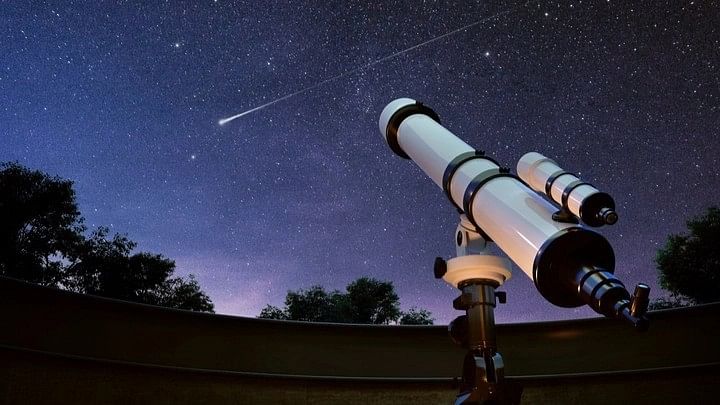
As part of the outreach programme, night sky watching is also organised at the main ground building of IISc on Tuesday, January 30, post 7.30 pm.
Credit: iStock Photo
Bengaluru: It was during the Covid-imposed break that scientist Aloke Kumar discovered the joy in photographing the beauty of the skies. Astrophotography became a hobby first, then an obsession.
Kumar will be sharing his knowledge with the public as part of A Celebration of Astronomy – a series of events that is being organised by the Astronomical Society of India (ASI) Public Outreach and Education Committee between January 31 and February 4 here.
Kumar’s master class on beginners’ guide to astrophotography is slated for January 31 at 7.15 pm.
"Basically, I switched from microscope to telescope. I was always admiring the beautiful pictures taken by others of nebulae and night skies. Covid break gave me plenty of time to explore this field," said the associate professor at the Indian Institute of Science (IISc), Bengaluru.
When he began, Kumar said he had zero knowledge of the subject, and it took him several attempts to get the pictures right. He said it helped that the skies were clear during the Covid time.
"Now, I have learnt the tricks of shooting even through polluted skies and editing the noises in photographs. I feel confident enough to teach people the science and art behind astrophotography," added Kumar.
"We have been organising these outreach programmes aimed at encouraging people towards traditional sciences for little over 10 years now. This is part of the annual meeting of the Indian Institute of Science Education and Research (IISER) Kolkata that is held in different cities every year. Last year, it was in Indore," said Prof Dibyendu Nandi of IISER Kolkata, who is also the current chairperson of the public outreach and education committee of ASI.
According to Nandi, traditional sciences take outreach seriously and put a lot of thought in curating events.
"We give an open call to host next year’s event at the annual meeting every year. Various scientific institutions get together and pitch to host the event. For this year, the scientific organisations of Bengaluru – IISc, Jawaharlal Nehru Planetarium, Indian Space Research Organisation (ISRO), Astrae (IISc Astronomy club), Kalam Labs, EDISLA and Modern Telescopes – gave a compelling proposal that had all the element for an informative event. So, we chose to hold the 42nd annual meeting in Bengaluru and have those outreach sessions here," said Nandi.
Dorje Angchuk, engineer in-charge at the Indian Astronomical Observatory Hanle in Leh Ladakh, who has been watching the skies for the last 26 years professionally, will be delivering a lecture on the Himalayan skies from Ladakh. The lecture is slated for January 31 at 6.30 pm and February 4 at 4.30 pm.
"We have been trying to showcase something that our people have forgotten. Night skies were part of our lives once – our ancestors revered the skies and watched them closely. But unfortunately, these days it is almost impossible to see the sky in cities like Delhi and Bengaluru," said Angchuk.
Angchuk said he was fortunate as Hanle observatory has one of the most productive telescopes and the pristine skies of Ladakh made his job a delight.
"And then, in 2010, I had a friend who was interested in astrophotography visiting us. In those few days he stayed with us, he took such beautiful pictures that I got hooked to the photography part of it," he added.
Part of the reason why his lectures are quite popular is that he mixes his passion and profession while presenting. "Also, since I am more of a landscape photographer, while shooting skies, I don’t focus only on stars and nebulae, but make it more of a study of the skies. That may have connected more people to the images," said Angchuk.
He agrees with Kumar that astrophotography took a serious turn after Covid.
"Until then, it was just a hobby for me too. But during Covid, one of my pictures on Comet New Wise became famous in social media and this changed the game for me," said Angchuk.
Thanks to the rising popularity, Angchuk said Leh Ladakh is positioning itself as an astro tourism destination as well. "The landscape is such that it is impossible to travel at night there. Watching skies fill that ‘what to do at night’ gap nicely."
Kumar said although an observatory and other equipment like a good camera and lens for serious Astro photographers will cost crores, for a beginner it is possible to set up at a relatively lower cost. "You can get a telescope even for Rs 10,000, and that is good enough for a beginner," he added.
To get people to love the mysteries of the sky needs more than classroom sessions. So, as part of the outreach programme, night sky watching is organised at the main ground building of IISc on Tuesday (January 30) post 7.30 pm. A Star Party is also organised at the JN planetarium on February 3, post 6 pm, by the teams from Kalam Lab and Astrae.
And for those who really want to understand the heart and science of sky watching, S Seetha, emeritus scientist from Raman Research Institute, Bengaluru, will be presenting the results from AstroSat, the first dedicated astronomy space mission from India.
"AstroSat has completed over eight years in orbit and is still working well. My talk will cover results based on observations of stars, stellar clusters, galaxies and compact objects like neutron stars and black holes," said the scientist.
Seetha’s talk is slated for February 3 at JN Planetarium at 4.30 pm.